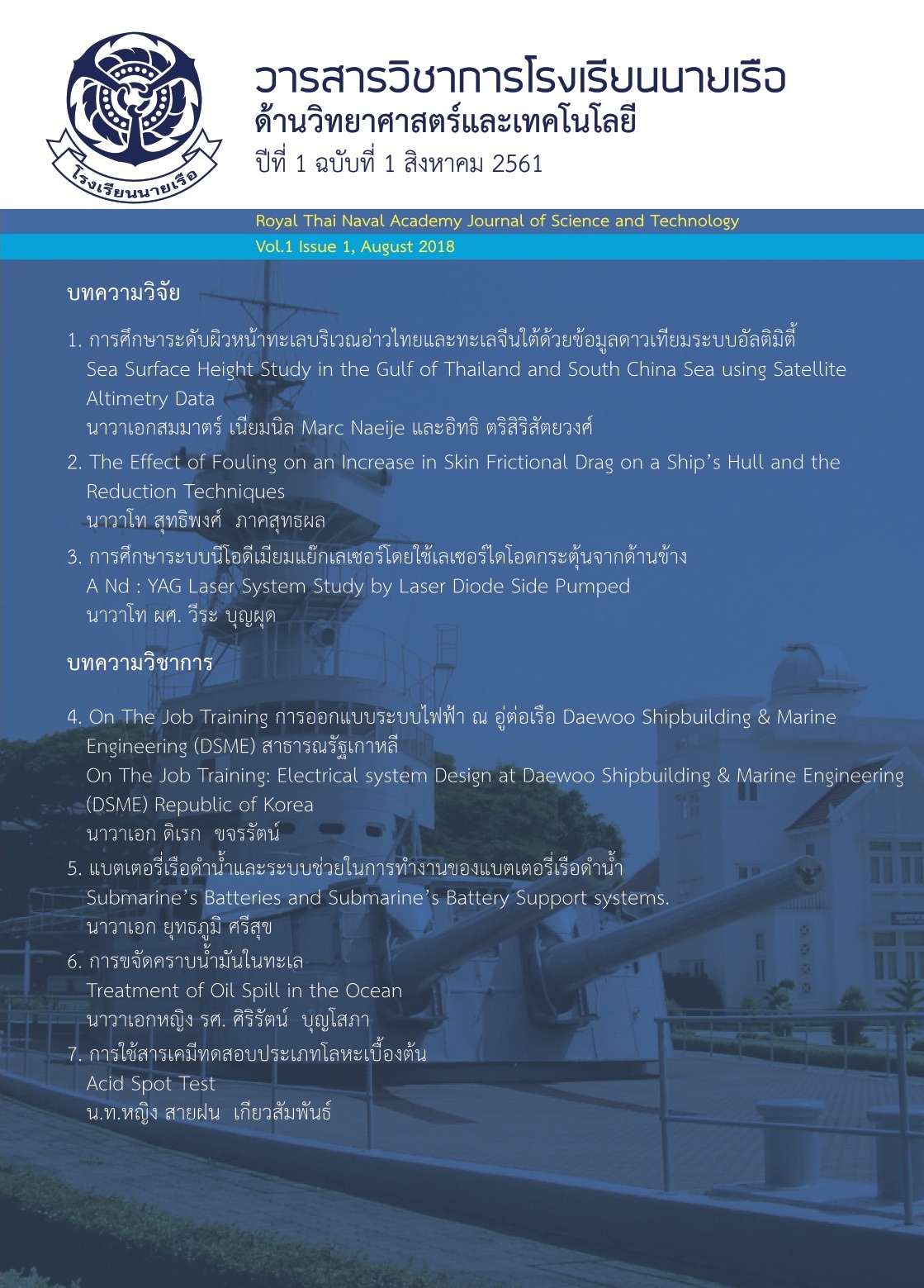ผลของความสกปรกของพื้นผิวต่อการเพิ่มความฝืดของตัวเรือและเทคนิคการลดแรงฝืด
Main Article Content
บทคัดย่อ
A ship’s hull is typically covered by fouling even though it is protectd by anti-fouling systems and this results in an increase in skin frictional drag, higher fuel consumption and eventually an extra operational cost. In this paper, the approaches to cope with ship’s hull fouling in the past such as anti-fouling ship-building materials and anti-fouling paints are provided with their limitations. Furthermore, the effects of fouling on an increase in skin frictional drag are presented in both terms of ship performance and an operating cost. It is found that, in the study of the Arleigh Burke-class destroyer, even the presence of small calcareous fouling or weed could generate an increase of 31% in shaft power and the operation cost of dealing with a fouling issue could be as high as US$ 2.4 million per ship per year. Three noticeable techniques of skin frictional drag reduction, namely air layer, outer-layer vetical blades and polymer additives, are introduced with the basic concepts. It is observed that the fully-continuous air layer could reduce more than 80% in the local frictional drag.
Article Details
เนื้อหาและข้อมูลในบทความที่ลงตีพิมพ์ในวารสารวิชาการโรงเรียนนายเรือ ด้านวิทยาศาสตร์และเทคโนโลยี ถือเป็นข้อคิดเห็นและความรับผิดชอบของผู้เขียนบทความโดยตรง ซึ่งกองบรรณาธิการวารสาร ไม่จำเป็นต้องเห็นด้วย หรือร่วมรับผิดชอบใด ๆ
บทความ ข้อมูล เนื้อหา รูปภาพ ฯลฯ ที่ได้รับการตีพิมพ์ในวารสารวิชาการโรงเรียนนายเรือ ด้านวิทยาศาสตร์และเทคโนโลยี ถือเป็นลิขสิทธิ์ของโรงเรียนนายเรือ หากบุคคลหรือหน่วยงานใดต้องการนำทั้งหมดหรือส่วนหนึ่งส่วนใดไปเผยแพร่ต่อหรือเพื่อกระทำการใด ๆ จะต้องได้รับอนุญาตเป็นลายลักษณ์อักษรจากโรงเรียนนายเรือก่อนเท่านั้น
เอกสารอ้างอิง
R.L. Townsin. (2010). “The ship hull fouling penalty,” Biofouling, vol. 19, pp.9-15.
V.B. Lewes. (1889). “The corrosion and fouling of steel and iron ships,” Trans INA, vol. 30, pp.362-389.
A.C.A. Holzapfel. (1904). “Ships Compositions,” Trans INA, vol. 46, pp.252-265.
M.P. Schultz, J.A. Bendick, E.R. Holm and W.M. Hertel.(2011). “Economic impact biofouling on a naval surface ship,” Biofouling, vol. 27, pp.87-98
D.E. Coles and E.A. Hirst. (1969). “Computation of turbulent boundary layers,” AFOSR-IFP Stanford Conference 2, Thermo-sciences Division, Stanford University, pp.1-45.
S. Watanabe, N. Nagamatsu, K. Yokoo, Y. Kawakami.(1969). “The augmentation of frictional resistance due to slime,” Journal of Kansai Society of Naval Architects, vol. 31, pp.45-51.
G.S. Bohlander. (1991). “Biofilm effect on drag: measurements on ships,” Polymers in a Marine Environment, Marine Management (Holdings), pp. 1-4.
G. Kempf. (1937). “One the effect of roughness on the resistance of ships,” Trans INA, vol. 79, pp.109-119.
A. Milne and G. Hails. (1971). “British Patent 1”.
Woods Hole Oceanographic Institution [WHOI]. (1952). “Marine fouling and its prevention,” Annapolis, MD: United States Naval Institute.
R.S. Alberte, S. Snyder, B.J. Zahuranec and M. Whetston. (1992). “Biofouling research needs for the United States Navy: program history and goals,” Biofouling, vol. 6, pp.91-95.
J. Jang, S.H. Choi, S. Ahn, B. Kim and J.S. Seo. (2014).“Experimental investigation of frictional resistance reduction with air layer on the hul bottom of a ship,” Int. J. Nav. Archit. Ocean Eng., vol. 6, pp363-379.
D.M. Bushnell and J.N. Hefner. (1990). “Viscous drag reduction in boundary layers, progress in astronautics and aeronautics,” The American Institute of Aeronautics and Astronautics Inc.
S.L. Ceccio and S.A. Makiharju. (2012). “Air lubirication drag reduction on great lakes ships,” Report of Great Lakes Maritime Research Institute, Michigan: Department of Naval Architecture and Marine Engineering, University of Michigan.
B.R. Elbing, E.S. Winkel, K. Lay, S.L. Ceccio, D.R. Dowling and M. Perlin. (2008). “Bubble-induced skin friction drag reduction and the abrupt transition to air-layer drag reduction,” Journal of Fluid Mechnanics, vol. 612, pp.201-236.
S.L. Ceccio. (2010). “Frictional drag reduction of external flows with bubble and gas injection,” Annual Review of Fluid Mechanics, vol. 42, pp.183-203.
N.H. An, S.H. Ryu, H.H. Chun and I. Lee. (2014). “An experimental assessment of resistance reduction and wake modification of a KVLCC model by using outer-layer vertical blades,” Int. J. nav. Archit. Ocean Eng., vol. 6, pp151-161.
J.W. Yang, H. Park, H.H. Chun, S.L. Ceccio, M. Perlin and I. Lee. ()2014. “Development and performance at high Reynolds number of a skin-friction reducing marine paint using polymer additives,” Ocean Engineering, vol. 84, pp183-193.


